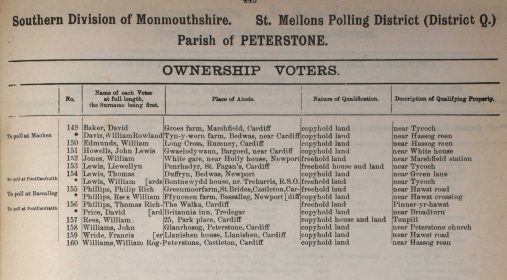Phillip Richards Phillips
A life at Greenmoor Farm

Phillip Richards Phillips was our 2nd great-uncle and the eldest brother of our great-grandfather John. Phillip was born at Greenmoor in St Brides, April 1853, as the first child of Phillp and Mary he was named Phillip in continuance of the family tradition. He was followed by seven siblings: Anne 1855, Thomas, 1858, John 1860 (our great-grandfather), William 1861. David 1863, Mary 1865, and Rees 1867.
Altthough attendance at school was not yet compulsory, Phillip and his siblings were all educated at the local school. They attended the mixed Board School which had been erected in 1850, it had capacity for seventy children but was usually half full. Whereas his brothers considered other occupations including grocer and architect, Phillp was always destined to succeed his father as the owner and master farmer of Greenmoor Farm.
Phillip first appeared on the census in 1861, he was 7 years old and at school, he already had four younger siblings. Also at Greenmoor were his parents, grandfather, (another Phillip Phillps), three farmworkers and a cousin, Mary J Evans. By the next census in 1871, Phillip was 17 and working full time on the farm. Eldest sister Ann has left home but the rest of the Phillips siblings were still at home. It was a busy household and there were two servants supporting the household.
Greenmoor Farm, also known as Green Moor, was a substantial property, 120-acres of land including salt marshes and lush grasslands. We found records of sheep, cows and pigs at the farm and regular sales of meadow and clover hay. The grasslands of the Gwent Levels were perfect for milk production and surplus stock was often made into cheese. During the 1860s and 1870s, quality pork from Greenmoor were part of the advertising at various butcher shops in Newport. The Philips family would be proud to know that some 160 years later, rare pork breeds are still sold from Greenmoor Farm.


By 1881 Phillip Sr. was nearing retirement and Phillip was taking a lead role on the farm. With his father and Uncle Thomas, another retired farmer, also living at Greenmoor, we would imagine Phillip was not short of advice! Also present at the farm were five of Phillips siblings. With all of the children now grown up and taking an active role, there was just one servant at Greenmoor, 14-year-old Ann Fairfax.
Phillip Sr. died on 15th December 1886 and by the 1891 census Philip was running the farm with his 65-year-old widowed mother. Younger brothers John, William and Rees were also working on the farm. Completing the household was a niece May Morgan and a servant named Mary Lewis. As a landowner Phillip was one of a small number of local people eligible to vote.
In 1894, at the age of 40, Phillip got married. On 27th March he wed Elizabeth Mary Ann Davies at St Cadwaladr Church in Bishton. Brother John Phillips was the witness. Elizabeth was 29 and had been born in Bethnal Green, London 1866, where her father had moved for work. When Elizabeth was still a young girl the family returned to Bishton, the birthplace of her father. Bishton was a small rural community to the east of Newport.
Elizabeth was the daughter of Noah, a farmer from Bishton, and Elizabeth Davies (n. Williams) from Redwick. After returning from London, they lived at Lower House in Bishton where Noah farmed 26 acres. At the time of her marriage to Phillip, Eizabeth was still living at home with six siblings.


Shortly after his marriage, Phillip’s mother Mary retired and he took full control of Greenmoor, becoming the third Phillip Phillips to run the farm. His mother Mary died in 1899 and was buried with her late husband at the local church. It was a decade of huge change at the farm; younger brother William died, and the remaining brothers left to pursue their own lives. Greenmoor became a much quieter place and by the 1901 census Phillip and Elizabeth are living there with just a niece named Maud Morgan, and two members of staff: Minnie Cochrane a domestic servant and Thomas Dunn a carter.
In 1901 Philip Phillips esq. was listed in the Kelly’s Directory as one of the three principal landowners in the area alongside Lord Tredegar and Charles Theodore Halswell Kemeys-Tynte esq. The population of St Brides in 1891 was 241. Phillip worked hard on the farm, and it continued to perform well.
In the 1890s Monmouthshire County Council’s Department of Agriculture decided that cheese and butter-making courses should be held around the county, and one was established at Greenmoor Farm. Tuition was free, but the girls were expected to pay towards their board and lodging at the farm. The small classes catered for the daughters of farmers from Rumney, St Mellons and other areas between Cardiff and Newport. One of the attendees at Greenmoor was a teenager named Gladys Scrivens of Pwll Mawr Farm in Rumney who learnt how to make butter and cheese.
The courses proved to be a great success: standards rose, and the average price of Caerphilly cheese increased. Wensleydale was also produced, and the girls learned how to make soft cheeses such as Gervais Cream and Cambridge. However, during World War I agricultural labourers enlisted or were conscripted, and farmers’ wives and daughters scaled back or ceased their cheese and butter-making activities. This led to the end of the classes at Greenmoor.


The household on the 1911 census consisted of Phillip and Elizabeth with a nephew, 14-year-old George Morgan from Bishton. George is combing part time work on the farm with attending school. Bethan Powell, a 18-year-old Domestic Servant, also lived at the farm. Elizabeth Phillips died 3rd December 1923 at the age of 58 and left her estate to her husband. As the couple didn’t have children there wasn’t a fifth Phillip Phillips to carry the name forward.
Phillip continued to work at Greenmoor into his 70s and died 25th August 1934 aged 80, he had spent his entire life at Greenmoor. Phillip was buried at St Bridget’s Church in St Brides with Elizabeth; they appear on the same page of the church burial book. The funeral was advertised as Gentlemen only. Phillip’s estate was administered by his brother Rees, nephew Brind and a solicitor, William Richards Davies. On the 1939 register Brind was living at Greenmoor with his retired parents and was listed as a Dairy Farmer.
